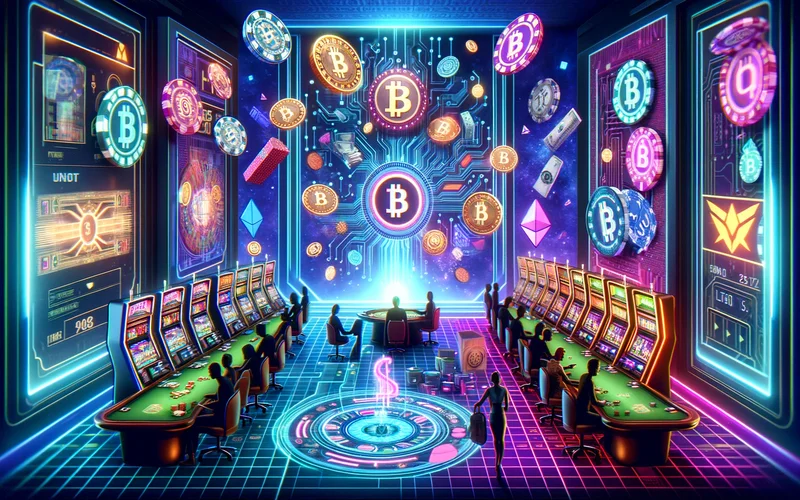The NFT phenomenon has swept across the globe, with projected global revenue expected to reach an astounding $2,4 million in 2024. Within a relatively brief period, NFT enthusiasts have crafted a rich glossary of terms. Many of the terms are on their way to becoming permanent in the digital language.
For those who are familiar with or are starting to gain interest in non-fungible tokens, learning the NFT jargon and slang is crucial, as these terms always appear in articles, Discord discussions, and Twitter feeds. Let’s see what the NFT lingo has to offer.

Explaining NFT Terminology
- Airdrop: The distribution of NFTs (usually from an emerging project) to individuals’ digital wallets without charge, often as a gesture of appreciation to early adopters.
- Ape (or “ape-ing into a project”): The act of purchasing NFTs from a new project without conducting prior research.
- ATH and ATL: Abbreviations for “all-time high” and “all-time low,” showing the highest and lowest historical values of an NFT or cryptocurrency.
- Bear market: A phase characterized by declining prices in NFT and cryptocurrency markets.
- Blockchain network: A decentralized ledger technology utilized for managing digital assets and transactions.
- Blue chip: A descriptor for top-tier NFT projects that are unlikely to falter.
- Bull market: A period marked by steady rises in NFT and cryptocurrency valuations.
- Burn: The act of erasing an NFT by sending it to the contract address, a feature permitted by numerous blockchains.
- Contract address: The address linked to the smart contract governing a nonfungible token or NFT collection.
- Crypto art: Digital art pieces minted on the blockchain and traded for cryptocurrencies.
- Crypto assets: Digital assets secured by cryptography and traded on transparent distributed ledgers.
- Cryptographic key: A string of data capable of locking or unlocking cryptographic functions, such as access to a crypto wallet and its contents.
- Crypto wallets: Tools – be they physical devices, web-based platforms, or software – employed for storing private keys and facilitating digital asset transactions.
- Decentralized network: A network where countless computers collectively process information, eliminating the need for a central authority.
- DeFi: Abbreviation for “decentralized finance,” comprising technologies facilitating financial instrument trading sans intermediaries.
- DYOR: Abbreviation for “do your research,” urging individuals to conduct thorough investigations rather than relying on external opinions.
- ERC-721: An Ethereum token standard facilitating the tracking and transferring of nonfungible tokens.
- ERC-1155: An Ethereum token standard enabling batch transfers for fungible, nonfungible, and semi-fungible tokens.
- Ethereum blockchain: The pioneering blockchain introducing an NFT token standard and currently dominating the NFT landscape.
- Floor price: The lowest listed price for an NFT within a collection.
- Fungible token: Tradable tokens lacking uniqueness, interchangeable with identical tokens.
- Generative art: Art generated autonomously, often employing AI-based image generation tools.
- HODL: A deliberate misspelling of “hold,” expressing steadfast commitment to holding onto tokens regardless of market fluctuations.
- ICO: Abbreviation for initial coin offering, a fundraising method involving the sale of new cryptocurrencies.
- IPFS (Interplanetary File System): A peer-to-peer file system housing files represented by NFTs.
- Minting: The process of creating an NFT
- Moon: When NFT projects achieve valuations previously deemed unattainable.
- NFT avatars: Unique avatars represented as NFTs for use in digital realms like the metaverse.
- NFT creator(s): Individuals or teams responsible for crafting NFTs or NFT projects.
- NFT degens: Individuals prone to speculative investments in NFT projects.
- NFT marketplaces: Online platforms facilitating NFT trading and creation.
- Non-fungible token: A digital asset with a unique identifier, irreplaceable by an identical token.
- OpenSea: The premier NFT marketplace for Ethereum-based tokens.
- P2E: Abbreviation for “play-to-earn,” referring to NFT or cryptocurrency-based games where players earn digital assets.
- PFP: Abbreviation for “profile picture,” denoting digital art NFTs often used as social media avatars.
- Rugpull: A fraudulent scheme wherein NFT creators escape with funds raised from token sales without fulfilling project commitments.
- Shilling: Vigorously promoting an NFT project to attract investors.
- Smart contract: On-chain programs execute automatically upon meeting predetermined conditions.
- Sweep the floor: When an entity acquires most or all NFTs listed at a collection’s floor price.
- Traits: Characteristics within an NFT collection influencing token rarity.
- Utility: Real-world value offered by an NFT beyond its potential resale value, such as exclusive access to events or merchandise.
- WAGMI: Abbreviation for “we’re all going to make it,” expressing optimism within the NFT community.
- Whale: Entities wielding significant capital capable of influencing market movements.
Why Understanding NFT Terminology is Important
When you have a comprehensive understanding of common NFT terminology, you can navigate the NFT marketplace with confidence. Things in the digital world evolve fast and keeping track of lingo is the key to understanding the basics of NFTs.
Disclaimer
FAQ
A non-fungible token (NFT) is a unique digital asset that represents ownership or proof of authenticity of items such as art, collectibles, and even real estate, stored on a blockchain.
Unlike cryptocurrencies such as Bitcoin and Ethereum, which are fungible and can be exchanged on a one-to-one basis, each NFT has a distinct value based on its unique attributes and cannot be exchanged on an equal basis.
Blockchain technology ensures the authenticity, provenance, and secure transfer of ownership of NFTs, making it a foundational aspect of the NFT ecosystem.
To start collecting NFTs, you'll need a digital wallet that supports NFTs, purchase some cryptocurrency like Ethereum, and then use it to buy NFTs from an NFT marketplace such as OpenSea.


